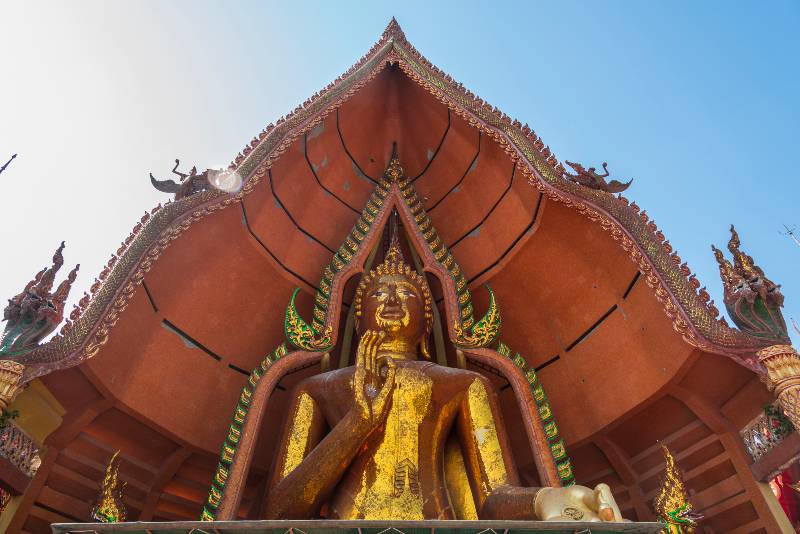Discovering Thailand’s Diverse Ethnic Mosaic
Thailand is a beautiful country with an incredibly diverse culture, history and set of ethnic groups. In this blog post, we’ll be taking an in-depth look at the various ethnic backgrounds that define Thailand’s national identity – from Thai to Lao, Shan and Khmer peoples. We will also explore how these different cultures have intertwined over the centuries to shape modern Thai society. So whether you are curious about traditional lifestyles or seeking insight into current affairs – get ready for a journey through some of Southeast Asia’s most extraordinary societies!
Thailand boasts a rich ethnic tapestry. The Central Thai or Siamese dominate the central region, while the Lao populate the northeastern Isan. The Khon Muang or Northern Thais hail from the north, and the Pak Tai or Southern Thais from the south. Diverse communities like Chinese Thais, Malay Muslims, and hill tribes like the Hmong and Karen further enrich the landscape.
Key Takeaways
- Thailand is home to a myriad of ethnic groups, each with its own unique history, culture, and traditions, contributing to the country’s rich tapestry.
- Migration patterns, neighboring countries, and historical events have played a significant role in shaping the ethnic landscape of Thailand.
- Understanding the various ethnic groups is crucial to appreciating Thailand’s festivals, languages, traditions, and its broader societal fabric.

A Journey Through Time: The Historical Influences on Thailand’s Diverse Ethnic Tapestry
Thailand’s ethnic mosaic is a vibrant, intricate tableau, blending varying hues cast by migration patterns, cultural interactions, and historical influences. This expansive portrait reflects a lively ebb and flow of people and cultures, moving across borders and through eras with concurrent shifts in political climates, economic opportunities, and social structures. The role of neighboring countries in shaping Thailand’s ethnic diversity adds further complexity, contributing indelible strokes that lend richness and depth to this vivid ethnic canvas.
Bursting with the vibrancy and richness of human existence, Thailand’s historical backdrop is enmeshed in fascinating narratives of migration, from ancient to modern times. Over the centuries, waves of migration, either voluntary or forced, have shaped the nation’s ethnic landscape, painting a powerful panorama of coexistence and cultural melding.
Regional neighbors, primarily Myanmar (Burma), Laos, Cambodia, and Malaysia, have played a significant part in shaping Thailand’s ethnic character, adding splashes of unique cultural identities and practices. As these nations ebbed and flowed through periods of expansion and contraction, various ethnic groups found themselves drawn into the Thai orbit as refugees, immigrants or, in some historical periods, as captives of war.
Ancient kingdoms such as Ayutthaya and Sukhothai absorbed immigrants from diverse lands, transforming into cosmopolitan centers of power and culture. The Mon, from present-day Myanmar, brought influential socio-religious customs, enquanto the Khmer of Cambodia imprinted their architectural and artistic prowess into Thailand’s cultural fabric.
Simultaneously, the historic Lao kingdoms, directly to the kingdom’s northeast, inscribed their language and cultural nuances into the interactive texture of Isan, Thailand’s largest region. Similarly, the Malay Peninsula, directly to the kingdom’s south, has channeled successive waves of Malay-Muslim communities into southern Thailand, defining the area’s distinct religio-cultural orientation.
In more recent times, mid-19th-century Chinese immigration significantly enriched Thailand’s cultural make-up, shaping its economic, political and culinary spheres in unmistakable ways. Top it off with sprinkles of vibrant Indian, Persian, Arab, European, and American influences that have interwoven throughout history’s broad loom, whether by trade, war, diplomacy, or marriage, Thailand’s robust ethnic tapestry unravels.
Such historical, geographical, and socio-cultural interactions have brewed a charming cultural potpourri, mirroring a thriving cohabitation of diverse ethnic groups. They’ve each added their distinct touch of color, texture, and design, resulting in the mosaic that is modern Thailand – lively, dynamic, and wonderfully complex.
Through its journey across time and space, Thailand stands as a testament to the transformative power of human migration and cultural intermingling. Its rich societal layers were crafted not merely by its homegrown ethnic groups, but also by its many visitors-turned-citizens. Together, they’ve shaped this magnificent and multifaceted kingdom, nurturing a legacy that continues to evolve and inspire.
Major Ethnic Groups
Thailand is not just renowned for its breathtaking landscapes and delicious cuisine but also for its rich tapestry of ethnic groups. Let’s embark on a journey to understand the major ethnic groups that have shaped this beautiful nation:
- Thai (Central Thai, Siamese): At the heart of Thailand, you’ll find the Central Thai or Siamese people. Predominantly residing in the central plains around Bangkok, they are the political and cultural torchbearers of the nation. Their language, Thai, serves as the national language, and their traditions, from the grandeur of the Songkran festival to the elegance of traditional Thai dance, have become emblematic of the country’s identity.
- Lao (Isan): Venture northeast, and you’ll encounter the vibrant Lao-speaking community of Isan. While they share many cultural similarities with their Laotian neighbors across the Mekong River, the Isan people have a distinct identity within Thailand. Their spicy cuisine, featuring dishes like Som Tam (papaya salad) and Laab (minced meat salad), is a testament to their unique cultural flavor.
- Khon Muang (Northern Thais): The mountainous terrains of Northern Thailand are home to the Khon Muang or Northern Thais. With a history steeped in the ancient Lanna Kingdom, they have a dialect, traditions, and cuisine that stand apart. If you’ve ever enjoyed the rich taste of a Khao Soi curry or been mesmerized by the Yi Peng lantern festival in Chiang Mai, you’ve touched a fragment of the Khon Muang culture.
- Pak Tai (Southern Thais): As you journey down to the sun-kissed beaches and lush islands of Southern Thailand, you’ll meet the Pak Tai or Southern Thais. Influenced by maritime trade routes and neighboring Malaysia, their culture is a beautiful blend of Thai, Malay, and even some Chinese elements. The rhythmic beats of the Nora dance or the spicy tang of a Massaman curry capture the essence of the Pak Tai spirit.
So, the next time you find yourself wandering the bustling streets of Bangkok, exploring the serene temples of Chiang Mai, or lounging on a beach in Phuket, remember that the beauty of Thailand is not just in its landscapes, but in the diverse tapestry of its people. Each ethnic group, with its stories, flavors, and traditions, contributes to the symphony that is Thailand.
Minority Ethnic Groups
Thailand’s rich cultural mosaic doesn’t end with its major ethnic groups. The country’s minority communities, each with its own unique traditions, languages, and histories, add layers of depth and intrigue to the Thai narrative. Let’s delve into these lesser-known but equally fascinating groups:
- Hill Tribes: Nestled amidst the verdant highlands of Northern Thailand, the Hill Tribes are a collection of various ethnic groups, each with its own distinct identity.
- Hmong: Known for their vibrant embroidered clothing and silver jewelry, the Hmong people have a rich oral tradition and are skilled farmers, often cultivating the mountainous terrains.
- Karen: The Karen are perhaps best known for the “long-neck” women of certain sub-groups, who wear brass coils around their necks. Beyond this, they have a deep connection to the forests and rivers, often living in stilt houses.
- Lisu: With origins tracing back to Tibet, the Lisu people are known for their colorful costumes and spirited festivals. They’re also adept hunters and traders.
- Akha: Recognizable by their intricate headdresses adorned with silver coins, the Akha have a rich spiritual life, with customs and rituals that mark various life stages.
- Chinese Thais: The bustling streets of Yaowarat in Bangkok give a glimpse into the world of Chinese Thais. Migrating over centuries, they’ve integrated seamlessly into Thai society while preserving their own traditions. From vibrant Chinese New Year celebrations to the mouth-watering dim sum delicacies, their influence is palpable in Thai culture and commerce.
- Malay-Muslims: Predominantly residing in the southern provinces near the Malaysian border, the Malay-Muslims bring a blend of Islamic culture and Malay traditions to Thailand’s cultural tapestry. Their melodious call to prayer, aromatic biryanis, and traditional ‘wayang kulit’ (shadow puppetry) showcase their unique identity.
- Mon and Khmer: These ancient ethnic groups have left an indelible mark on Thailand’s history and architecture.
- Mon: Originally from Myanmar, the Mon people have influenced Thai Buddhism and arts. Their ancient city of Dvaravati left behind artifacts and stupas that hint at their grand past.
- Khmer: While many associate the Khmer with Cambodia, their influence extends into Northeast Thailand. The magnificent stone temples in places like Phimai are a testament to the Khmer architectural legacy in Thailand.
As you traverse the diverse landscapes of Thailand, from its bustling cities to its serene countryside, remember that every corner holds stories of these minority groups. Their songs, dances, crafts, and tales are threads that, when woven together, create the intricate and beautiful fabric of Thai society.
Cultural Significance
Thailand, often referred to as the “Land of Smiles,” is a treasure trove of cultural experiences. The country’s rich ethnic diversity is mirrored in its myriad of traditions, festivals, rituals, languages, and dialects. Let’s embark on a journey to understand the cultural significance of these groups and how they enrich the Thai tapestry:
Traditions, Festivals, and Rituals:
- Thai (Central Thai, Siamese): The Songkran festival, marking the Thai New Year, sees the entire nation engage in playful water fights, symbolizing purification. The Loy Krathong festival, where people release decorated baskets onto water bodies, is another central Thai tradition, representing the letting go of negativity.
- Lao (Isan): The Rocket Festival, or ‘Bun Bang Fai,’ is a unique Isan tradition. Communities gather to launch homemade rockets, praying for rain and celebrating with dances and parades.
- Khon Muang (Northern Thais): The Yi Peng Lantern Festival in Chiang Mai is a sight to behold. Thousands of lanterns illuminate the night sky, symbolizing new beginnings and the release of misfortunes.
- Pak Tai (Southern Thais): The Pak Tai communities celebrate the Chak Phra Festival, marking the return of Buddha from heaven. It involves processions of Buddha images on land and water.
- Hill Tribes: Each tribe has its unique festivals. For instance, the Hmong New Year is celebrated with colorful attire, ball tossing games, and feasts. The Karen, on the other hand, have a wrist-tying ceremony to ward off bad spirits and bring good luck.
- Chinese Thais: The Lunar New Year is celebrated with lion dances, red lanterns, and family reunions. The Hungry Ghost Festival sees offerings made to appease wandering spirits.
- Malay-Muslims: Eid al-Fitr, marking the end of Ramadan, is celebrated with communal prayers, feasts, and giving to the needy.
- Mon and Khmer: The Mon celebrate the Songkran festival with water pouring on Buddha images. The Khmer in Thailand, similar to Cambodia, celebrate the Water Festival, marking the reversal of the flow of the Tonle Sap River.
Language and Dialect Variations:
- Thai (Central Thai, Siamese): They speak the standard Thai language, which is taught in schools and used in official capacities.
- Lao (Isan): The Isan language, closely related to Lao, is spoken in the northeastern region.
- Khon Muang (Northern Thais): The Northern Thai language, or Kham Muang, is distinct and has its script.
- Pak Tai (Southern Thais): The Southern Thai dialect has influences from Malay due to its geographical proximity.
- Hill Tribes: Each tribe has its language. For instance, the Hmong speak Hmongic languages, while the Karen have their Karenic languages.
- Chinese Thais: Older generations might still speak Teochew, Hokkien, or Cantonese, though many have shifted to Thai.
- Malay-Muslims: They primarily speak Yawi, a dialect of Malay, especially in the southern provinces.
- Mon and Khmer: The Mon language is still spoken among Mon communities, while the Khmer in Thailand speak a dialect similar to Cambodian Khmer.
In essence, the cultural significance of Thailand’s ethnic groups is a testament to the country’s rich heritage. Each group, with its traditions and languages, adds a unique hue to the vibrant palette of Thai culture. Whether you’re listening to the melodic tones of a dialect or partaking in a local festival, you’re experiencing the heart and soul of Thailand.
Modern Day Integration
Thailand, a nation that has gracefully danced between the ancient and the modern, is a melting pot of ethnicities, each contributing to the vibrant rhythm of its contemporary society. As we delve into the modern-day integration of these ethnic groups, we’ll uncover the roles they play, the challenges they face, and the opportunities that lie ahead in the ever-evolving Thai tapestry.
Role of Ethnic Groups in Contemporary Thai Society:
- Thai (Central Thai, Siamese): As the dominant group, they play a pivotal role in shaping national policies, politics, and cultural norms. Their traditions, from the grand Songkran celebrations to the serene Loy Krathong festival, have become national symbols, celebrated with fervor across the country.
- Lao (Isan): The Isan people, with their rich agricultural heritage, are the backbone of Thailand’s agrarian economy. Moreover, their vibrant music, Mor Lam, and spicy cuisine have found fans nationwide, adding a zesty flavor to the Thai cultural scene.
- Khon Muang (Northern Thais): Tourism, arts, and crafts from the northern region, deeply influenced by the Khon Muang, significantly contribute to the nation’s economy. The serene Lanna architecture and the enchanting Yi Peng festival are just a few examples of their cultural contributions.
- Pak Tai (Southern Thais): With their proximity to the sea, the Pak Tai community plays a significant role in the maritime and fishing industries. Their unique blend of Thai and Malay cultures also adds a distinct charm to Thailand’s southern provinces.
- Hill Tribes: While traditionally associated with agriculture, many hill tribes have ventured into eco-tourism, showcasing their rich traditions and pristine landscapes to curious travelers.
- Chinese Thais: Integral to Thailand’s commerce and business sectors, Chinese Thais have a significant influence in urban centers, especially Bangkok. Their entrepreneurial spirit is evident in the bustling markets of Yaowarat and beyond.
- Malay-Muslims: Beyond their role in the southern provinces, Malay-Muslims have also made significant contributions in arts, cuisine, and trade.
- Mon and Khmer: These ancient communities, with their deep-rooted traditions, play a role in preserving Thailand’s historical and architectural heritage, especially in regions close to Myanmar and Cambodia.
Challenges and Opportunities for Integration:
- Challenges: Like many nations with diverse ethnic groups, Thailand faces challenges in ensuring equal representation and opportunities for all. Language barriers, especially for minority groups, can hinder access to education and public services. There’s also a delicate balance to maintain between preserving traditional ways of life and embracing modernity. In some regions, particularly the deep south, political and religious tensions have posed challenges to integration.
- Opportunities: Thailand’s diversity is its strength. By promoting inclusive education and celebrating the traditions of all ethnic groups, Thailand can boost its cultural tourism and global appeal. Modern media, including films, music, and literature, can play a role in showcasing and appreciating the stories of each community. Collaborative initiatives, where communities share knowledge and resources, can also pave the way for a harmonious and integrated society.
In the heart of Southeast Asia, Thailand stands as a testament to the beauty of diversity. As the nation strides forward, it carries with it the melodies, tales, and dreams of every ethnic group, weaving them into a story that is uniquely and beautifully Thai.

Ethnic Groups of Thailand FAQs
What are the main ethnic groups in Thailand?
Thailand’s main ethnic groups include the Central Thai or Siamese, predominant in the central region; the Lao of the northeastern Isan area; the Khon Muang or Northern Thais from the north; and the Pak Tai or Southern Thais. Additionally, there are significant Chinese, Malay-Muslim, and various hill tribe communities.
What is the ethnic name of Thailand?
In Thailand, all citizens are referred to as “Thai”. Interestingly, the largest ethnic group in Thailand is also called “Thai”. This is not by chance, but rather a deliberate effort by the Thai government to foster a sense of national unity, rooted in a shared ethnic heritage.
What is the ethnic breakdown in Thailand?
Thailand is home to over 30 diverse ethnic groups, with the Thai ethnicity comprising around 95% of the population. Among the Thai ethnic group, there are descendants from various races including Chinese, Mon, Khmer, Lao, and Indian.
What is the indigenous group in Thailand?
The Hmong, Karen, Lisu, Mien, Akha, Lahu, Lua, Thin, and Khamu tribes are officially recognized as indigenous peoples of Thailand.
What are the people of Thailand called?
The people of Thailand are commonly referred to as “Thais” (plural), while an individual from Thailand is known as “Thai”.
Conclusion
At the end of the day, there’s a great deal to explore and uncover when it comes to Thailand’s ethnic landscape. Delving into this subject can help us better understand and respect the cultural heritage and identity of all Thais. Looking at each individual group provides insight into how they interact with each other, creating a harmonious, balanced union in what we know as Thailand today. If you’re interested in learning more, be sure to subscribe to our newsletter for the best information about living in Thailand or reach out to us with your questions — we’ll be more than happy to offer any assistance!






